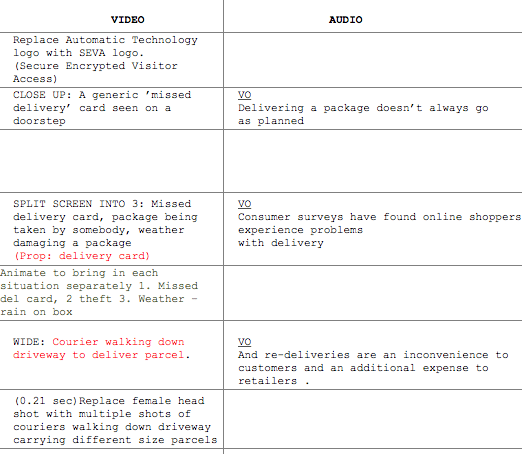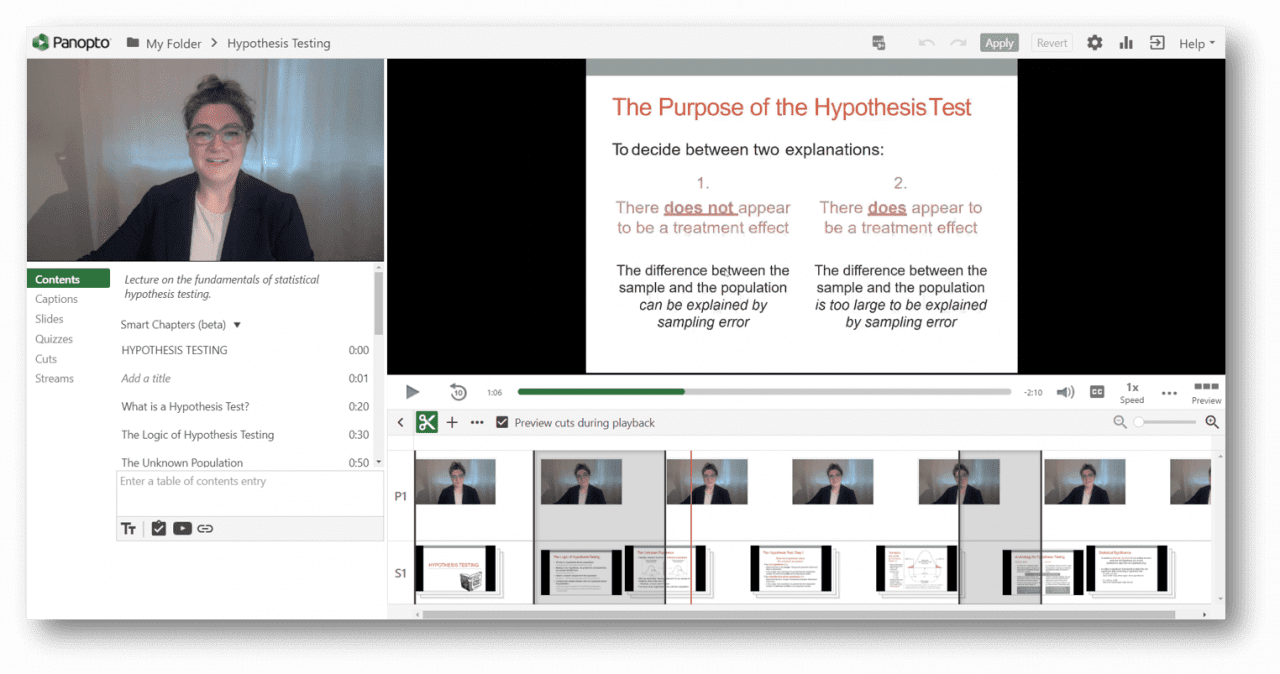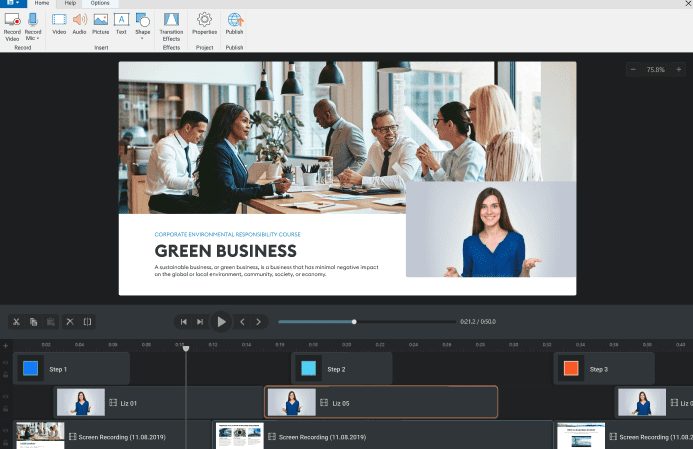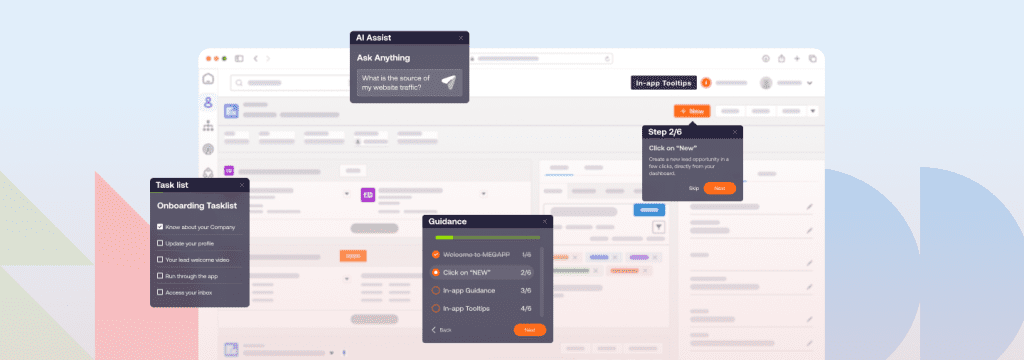Training videos are recorded visual tools used to deliver educational or instructional content to employees, often combining voice, screen captures, motion graphics, or live demonstrations. In 2025, video training has become essential: over 88% of large companies now use virtual classroom or video broadcasting tools as core parts of their learning programs.
For L&D leaders, relying solely on text-based courses or SOPs leaves gaps in engagement, retention, and skill application. Videos offer consistency, scalability, and clarity that traditional formats struggle to match, especially when paired with interactive features and in-workflow supports.
In this article, we cover why training videos work, how to create them effectively, top examples, and how Whatfix brings video into the flow of work.
What Are Corporate Training Videos?
Corporate training videos are structured video assets created to teach employees new skills, explain processes, or reinforce compliance requirements. Unlike ad-hoc recordings, these videos are designed with clear learning objectives, scripts, and visuals to deliver consistent training across an organization.
They can take many forms like software walkthroughs, animated explainers, scenario reenactments, or microlearning clips. But the goal is the same: provide engaging, repeatable, and scalable learning content. For L&D teams, training videos reduce instructor time, standardize knowledge delivery, and give employees on-demand access to learning resources when and where they need them.
When to Use Training Videos and When Not To
Training videos can be powerful tools, but they aren’t always the right choice. Knowing when to use video versus another learning format ensures employees get the most value and organizations don’t waste resources.
When training videos work best:
- Software demos and walkthroughs: Videos are ideal for demonstrating digital workflows step by step, giving employees a visual reference before practicing.
- Safety training: Complex procedures like equipment handling or lab safety benefit from video, which shows the physical context more clearly than text.
- Scenario-based learning: Roleplay situations such as customer conversations or compliance breaches come alive on video, helping employees see behaviors in action.
- Compliance briefings: When regulations change, videos help standardize the message and ensure all employees receive the same instruction.
When to consider other formats instead:
- Interactive guides: For process-heavy, click-by-click tasks, in-app walkthroughs or smart tips work better than static videos.
- Job aids: Quick-reference checklists or infographics are often more practical than replaying a video for simple, repeatable steps.
- Simulations: For regulated or high-stakes workflows, sandbox practice with tools like Whatfix Mirror allows hands-on training that videos alone cannot replicate.
The key is balance: videos deliver clarity and engagement, but should be paired with interactive formats that let employees apply, practice, and reinforce what they’ve learned.
Core Types of Training Videos and When to Use Each
Different formats serve different training goals. Choosing the right type of training video ensures your content is both engaging and effective.
- Screen Recordings: Best for software training and digital workflows. Screen captures show employees exactly where to click and how to navigate applications. Use them for onboarding into new tools or demonstrating updates.
- Software Walkthroughs: Interactive walkthrough-style videos combine narration with guided clicks. They’re effective for complex systems like CRM or ERP platforms, where learners need a clear process demonstration before practicing in-app.
- Scenario and Roleplay Videos: Dramatized interactions model real-world situations such as sales calls, customer service conversations, or compliance breaches. Use them to build soft skills, reinforce behavioral standards, and prepare employees for high-stakes situations.
- Microlearning Clips: Short videos (under five minutes) that focus on one task or concept. Perfect for just-in-time learning, reinforcing key points, or helping employees revisit critical steps without rewatching long modules.
- Animated Explainers: Motion graphics and animation simplify abstract or technical concepts. They work well for introducing new policies, explaining processes, or visualizing data flows in compliance and safety training.
- Interactive Video with Quizzes: Learners engage by making choices or answering questions as the video plays. This format is best for reinforcing retention, tracking comprehension, and creating more active learning experiences.
How to Create Training Videos for Your Employees
While video content can be intimidating, with modern L&D tools like LMS, instructional design software, and screen recording tools, video creation has never been more accessible.
You can use the following steps to guide your video training content creation journey.
1. Set goals and objectives for your training videos
Before creating your training videos, be sure to both understand your training goals, as well as your learning objectives for your employees.
- Understand your goal(s): Before creating a training video, dig into your training strategy to understand the business goal and outcomes you want to achieve. Partner with your instructional design team and review the training needs together. Understanding your training goals and objectives will help clarify the full scope of your video project.
- Define your learning objective: Define your learning objective in the sense that after watching this training video, what should employees learn or be able to do? Your learning objective should be clear, concise, and relevant. Defining a learning objective helps you provide clear instructions with achievable outcomes.
2. Create a learner profile for your audience
Ask yourself – who is this training video for? Developing a thorough understanding of your audience and their needs will guide key decisions about your videos. Take time to research and dig into the demographics to understand the education, age, professional organizations, job functions, interests, and concerns of your audience.
3. Choose your topics for your training videos
Once you have a thorough understanding of your audience, the next thing to do is select a training topic relevant to them. People easily abandon videos that don’t provide them with the information they are looking for, so selecting an exciting and important topic according to your audience is critical.
A research study by Techsmith shows that the number one reason people watch a video is because they are interested in the topic. A good practice here is to pick ONE topic per video. This narrows your scope and makes your training videos more focused and more accessible to create.
4. Select your video format and type
The next step in our checklist on how to create training videos is to choose a format for your video, whether that is an animated training video, a scenario-based video, a screen recording, etc.
All these video formats require different levels of time and effort. Consider the availability of your resources, timeline, goals, and stakeholder expectations to select the ideal video training format for your training program.
5. Create your training video script and storyboard
The most important prep task in creating training videos is to write a script or a storyboard. A storyboard is the visual representation of each shot in the video, and the script is an outline of the video audio and dialogue.
A well-written script is essential to creating an effective training video. Without a script, your videos will turn out to be confusing and disjointed. Writing a script takes practice, but here are a few tips for you to get started:
- Keep it conversational, not overly professional.
- Make it well-organized and incredibly easy-to-understand
- Cut out all the extra words and unnecessary jargon.
- Use small words that everyone understands.
- Explain what you’re doing and why you’re doing it.
- Be sure to read your script aloud before you record.
- Get feedback from teammates.
Now that you have your script set, it’s time to match the text to visual representations, that is, to create storyboards. You don’t really have to be an artist to create storyboards. Remember to keep it simple. Add some sketches or throw in images from Google’s search engine. Honestly, you don’t need to spend a lot of time creating the storyboard. Focus more on the video development process and bring ideas to life.
Scripts and storyboards go hand in hand. They help you better evaluate a video’s audio and visuals and decide what’s best for the overall objective of your training video.

6. Prepare your video equipment
When you’re ready to start creating a training video, there’s video equipment you need to acquire to ensure your video looks and sounds good. The equipment requirements depended on the video type. You may need fancy equipment like an HD video camera, lighting kit, tripod, or just a license to video animation software.
Video training software makes it easier for L&D teams to quickly produce impactful training videos for their employees. These tools help you create engaging videos without spending much money on equipment, video editing services, and other resources.
7. Record your training video
Once you are done with the prep work, it’s time to finally start recording. You don’t have to be a professional host to create a great video. Anyone can record an excellent recording or screencast with some practice. With modern HD webcams and smartphone cameras, anyone can record a training video. Be sure to dedicate an afternoon to recording multiple training videos.

8. Edit your training videos
Once you’ve recorded the footage, there are several ways to edit a video and make it visually engaging. As discussed above, there are many simple-to-use video editing software that make editing a lot less intimidating. These tools are used to manipulate and arrange video files, edit the audio, add graphics and annotations, color correct, and much more.
There are different sophistication levels of video editing software learning and development teams can leverage, from more advanced tools like Adobe Premier Pro, to basic video editing tools available through apps like Canva. There are now Gen-AI-powered video editing tools to help overcome the technical skills gap associated with editing tools.
Video editing tools come packaged with a lot of features, including:
- Custom video templates and branding options
- Embeddable quizzes and questions
- Video analytics
- LMS integrations
- Resources including motion backgrounds, animations, images, and music

9. Review the training videos with corporate stakeholders and gather feedback
Have your stakeholders or colleagues review your training video once you’ve got an early draft for your training video. Take this feedback from your teammates and use it to iterate and improve on your initial video. Feedback is the best way to ensure no mistakes and that the final product is polished.
10. Share and distribute your training videos
Once your training video is complete, it’s time to get it in front of your audience. You can post it on the company’s website, incorporate it into the monthly newsletter, or share it across social media channels.
Finally, think about where your video will live. If your videos are for an internal audience, they’ll most likely be hosted on an LMS or an internal video hosting tool. If your videos are for an external audience, many online platforms are available for hosting, such as YouTube, Vimeo, or Wistia. These video hosting tools provide various levels of analytics to track their impact.
11. Deliver and reinforce in the flow of work
Creating training videos is only effective if employees can recall and apply them when it matters most. Instead of leaving videos buried in an LMS or shared drive, bring them into the flow of work with a digital adoption platform.
With Whatfix digital adoption platform, you can:
- Embed training videos directly inside enterprise applications so employees see them in context while completing tasks.
- Pair videos with interactive walkthroughs, task lists, and nudges to reinforce critical steps over time.
- Surface videos through Self Help so employees can quickly revisit a clip the moment they need it.
- Track how videos impact adoption, error rates, and time-to-proficiency with built-in analytics.
This ensures that your training videos don’t just get watched once, they actively drive behavior change, reduce errors, and improve performance in daily workflows.
Training Video Checklist Template
Download a customizable copy of our free training video checklist to start creating effective training videos for your employees.
19 Examples of Effective Corporate Training Videos
Using videos for employee training promises better knowledge retention, improved employee performance, and higher overall L&D success.
If you’re looking for inspiration to create your training videos, we’ve compiled this list of 19 killer examples to get you started.
1. ActiveGrowth’s Video: How to Use Loom
ActiveGrowth’s 10-minute employee training video is different from a standard training video. It’s a live-action video with contributions from multiple team members on the same topic—how to use Loom for better teamwork and fewer meetings.
The video features various ActiveGrowth employees working from their homes. It shows their take on using Loom for workplace collaboration. This detailed video shows different scenarios of how meetings can waste time and impact employee productivity. On the flip side, short Loom videos work well in many scenarios.
What makes this training video example effective?
- The video includes multiple characters and unique camera action, giving it the appeal of an engaging movie.
- The video emphasizes remote and hybrid teams’ problems with meetings and presents several use cases for asynchronous communication via Loom.
- The video draws on real-life examples to train employees for such situations and create a healthy culture of async work.
2. Gong’s Video: Objection Handling
Gong’s sales training video is a great example that can inspire your videos. Nearly 30 minutes long, this detailed training video example teaches salespeople the art of handling sales objections like a pro. This presentation video gives employees a walkthrough of the seven stages Gong follows in its B2B sales process.
The presentation includes text and visual elements to keep the video informative yet light. Since it’s a long video, a summary section at the end reinforces all the information to help viewers retain most of it.
What makes this training video example effective?
- This presentation-based video presents static content, keeping viewers’ focus on the audio and increasing learning retention.
- The video comes with a slide deck that employees can download and use as a job aid anytime they’re on an actual sales call.
- The video conveys its solutions through real-life scenarios, which makes the message more actionable.
3. Vyond’s Video: Mental Health in the Workplace
This training video from Vyond focuses on mental health in the workplace. Its an animated video that speaks directly to managers, especially those leading training remote teams. It starts with a few reasons why mental health has become an essential topic of discussion in the workplace. It goes on to highlight a few ways in which managers can support their employees.
The video presents reasonable solutions on such a critical, timely subject. Its minimalistic animation, slow music, and empathetic narration make the 2-minute video a thought-provoking watch.
What makes this training video example effective?
- The video addresses only one specific target audience (managers) and delivers relevant information for this audience.
- The voice change in the audio shows a role-play format, making it easier for managers to embrace the main message.
- While proposing several solutions, the video tells employees about the company’s mental health program.
4. PwC’s Video: Diversity and Inclusion
PwC presents a unique take on diversity and inclusion training with this concept video. It’s intended for all employees at the workplace and conveys a strong message regarding diversity.
The video uses storytelling to convey a gripping story and tell employees where they might be going wrong—intentionally or unintentionally. It also ties ethnic and racial discrimination to our cognitive capabilities and highlights how we’re wired to think a certain way. In the end, the video calls for self-reflection and the need to move beyond this way of thinking.
What makes this training video example effective?
- The video brings out the right emotions with a strong storyline and impactful sound effects.
- The message conveys new information about people’s inherent beliefs, capturing their interest until the end.
- The live-action video uses real people from diverse backgrounds to create a more realistic appeal and deliver a more substantial impact by the end.
5. Airtable’s Video: Customer Research
Airtable’s 10-minute video on using its tool for customer research is an excellent employee training video example. It’s a detailed screen recording by one of Airtable’s marketing researchers for the company’s marketing and research teams. The video follows him as he explains the process of collecting and organizing customer research on Airtable.
The video also has a sales touch since it starts with a glimpse of what customer research would look like on a spreadsheet before switching to Airtable.
What makes this training video example effective?
- The video gives viewers everything they’d need to use Airtable for customer research. It’s direct and detailed with no fluff content.
- The video wins viewers’ confidence since it’s coming from a leading researcher at the company with the expertise to show them how it’s done.
- The video is neatly divided into different sections, each covering one topic, to give employees a better viewing experience.
6. Xenium HR’s Video: Giving Constructive Feedback
This short employee training video by Xenium HR targets the topic of feedback in the workplace. It focuses on anyone in a leadership or managerial role where they’re required to share feedback with their colleagues. The live-action video uses the role-play technique to show exactly what constructive feedback looks like in action. It’s a short conversation between two people where each party conveys their views politely.
What makes this training video example effective?
- This video is an excellent example of role-play training employees about specific scenarios.
- Unlike presentations and animated videos, this video gives employees hands-on training on delivering constructive feedback.
- The video is under 2 minutes, so employees can watch it conveniently and learn a crucial lesson.
7. Deloitte’s Video: Customer Onboarding
Deloitte Digital Bank created this short training video for its sales and customer success teams to highlight the benefits of its product, its Digital Bank Accelerator. The video presents several customer pain points, then introduces its accelerator as a viable solution.
The second half of the video goes into the depths of the product’s functionality. It guides employees on how to operate the application. It also explains the backend technology to help sales and customer-facing teams handle objections effectively.
What makes this training video example effective?
- The collection of short video clips and overlay text highlighting the main details minimizes distraction and keeps the focus on the main message.
- The background narrative in a human voice adds a personal touch, making it easier for employees to pay attention.
- The video follows a clear storyline—it touches upon the challenges, introduces a solution, elaborates on the solution, and ends with a CTA.
8. Winning by Design’s Video: Customer Success Skills
Winning by Design’s 4-minute training video works more as a quick tutorial on scaling the customer success team. While it starts by painting a picture for the CEO or VP of Customer Success at a big organization, the primary message focuses on building a bigger and stronger CS team.
In just under 4 minutes, the video gives the company’s CS team and leaders a playbook for managing a growing clientele. The video covers broader ground by sharing advice on building inter-departmental collaboration with the marketing and sales teams.
What makes this training video example effective?
- The live-action video focuses solely on the speaker without any distractions. It keeps the viewers’ attention on the speaker at all times.
- The video features hand illustrations by the speaker instead of awkward screencasts or distracting overlays. This adds a dash of personalization to it.
- The speaker doesn’t beat around the bush and jumps straight to the action points, making the video more value-packed.
9. AMAZE Org’s Video: What Is Sexual Harassment
AMAZE Org designed this 2-minute employee training video to create awareness on a heavy topic, sexual harassment. Any organization or group can use this video to give employees a primer on what constitutes an act of sexual harassment and the best ways to address it. The animated video uses fictitious characters to show gestures and actions considered harassment.
What makes this training video example effective?
- The animation in the video demonstrates actions that might come under the radar of sexual harassment within or outside the workplace.
- The video offers helpful advice on how to deal with the situation if you’re a victim of harassment.
- The audio track matches the video’s style and conveys the message even with merging sounds of a few characters.
10. MasterControl’s Video: SOPs and Work Instructions
An 18-minute video by MasterControl, this training video example is sourced from a seminar session on digitizing SOPs and work instructions. It’s a detailed resource on creating a digital library of SOPs and work instructions—covering key points like why you need such a library, how to build it, the costs involved, and how to update it consistently.
The video starts with a conversation between the two panelists. But it also references a presentation with the main talking points of the session.
What makes this training video example effective?
- The conversation between two subject matter experts makes the content more credible and valuable.
- The video transitions between a seminar and a presentation, filled with pattern interrupts to hold viewers’ attention till the end.
- The video’s design is relatively simple, with a steady camera recording and a simple slide deck to convey the information—little to no distractions.
11. Zoho’s Video: Employee Overview Walkthrough
Zoho People’s training video covers a start-to-finish tool demo from a team member’s perspective. This video is meant for the new sales and customer success team members to pitch the right features and troubleshoot any queries from the clients. This 14-minute onboarding video covers every feature to give employees a complete rundown of the tool’s capabilities and interface.
What makes this training video example effective?
- The screen recording video serves a single goal—to tell viewers how to use the employee account on Zoho People.
- Even though it’s designed for employee training, the video doubles as a helpful resource for users to self-troubleshoot any doubts.
- The video uses micro-animation to make the recorded content look more intuitive and seamless.
12. InvestorLift’s Video: Lead Management Using Zapier
A detailed employee training video by InvestorLift, this 40-minute CRM training video teaches viewers all the tips and tricks for lead management on your CRM and Zapier. This is designed for employees on the sales, customer support, and business development teams.
It’s a video recording with a small bubble showing the speaker’s face to add a human touch. The video offers extensive step-by-step instructions to automate your lead management process within CRM software via Zapier.
What makes this training video example effective?
- The video gives a start-to-finish rundown on lead management using Zapier and a CRM tool, making it a comprehensive resource.
- The speaker performs all the actions live on the screen to make the video beginner-friendly.
- This video is an ideal example of when you don’t have a big budget but want to create quality resources.
13. HSEnvolvy’s Video: Workplace Safety
HSEnvolvy’s workplace safety training video is a short film on how things can go wrong within a workplace, putting your life in danger if you don’t follow all safety rules. This video targets employees working more physically-intense jobs, such as manufacturing or logistics.
The video features excellent cinematography to keep the focus on workplace accidents. Paired with high-quality audio, it conveys the importance of meeting safety instructions at all times.
What makes this training video example effective?
- The video captures viewers’ attention from the start and keeps them hooked till the end with its outstanding cinematography.
- The video’s storytelling and narrative build suspense until the end, when everything falls into place.
- The video shows dramatic action—like a movie—to depict how employees can risk their lives by not following safety rules.
14.Canity’s Video: Customer Service
Canity uses a short 1.5-minute video to inform viewers about the best ways to deal with angry and upset customers. As a part of the company’s longer series on customer service training, this animated video is engaging and shares valuable insights for customer success employees.
The video follows the main narrative and a few examples showing how these tips work in real life. In essence, it’s crisp and punchy enough for viewers to bookmark it for the future.
What makes this training video example effective?
- The animations make the video interactive and exciting compared to the standard employee training videos.
- Employees can use this short video for on-demand learning when dealing with an angry customer.
- The real-life examples in the video make it more actionable and helpful for all viewers.
15. SEO Frank’s Video: SEO Audit
SEO Frank’s 50-minute-long training video gives you a deep dive into the process of conducting an SEO audit. It’s an exhaustive screen-recorded video covering a 17-point checklist of things to do for a successful SEO audit. The speaker walks you through every item in this checklist with a stepwise breakdown of performing all the tasks.
What makes this training video example effective?
- The video is pretty comprehensive and covers everything you’d need to know about an SEO audit.
- The speaker starts every task from scratch and covers specific details about using particular features within a tool.
- The video also includes real-life examples of an audit report and how you can interpret it.
16. Google interns’ first week video
Google’s “Interns’ first-week” video incorporates different clips from interns sharing their perspectives on Google’s company culture. The video gives you a good look at its offices and surroundings. The interns speak to you directly about the company’s work-life balance and creativity in the workplace. This video serves as an excellent intro to what it’s like to be an employee at Google and makes you want to be a part of its awesome culture.
The takeaway: Infusing your video with specifics about your company culture coming directly from employees (in this example, interns) makes the onboarding process more natural for new employees who feel overwhelmed by the magnitude of the company.
17. GrubHub’s new driver onboarding video
To help out nervous recruits, Grubhub made a training video of a fellow driver walking them through his deliveries and sharing his tips and tricks. The video is very informational and highlights a list of standard operating procedures that help ensure a smooth delivery. The video is simple, short, and discusses the insider secrets of the job – with a personal touch.
The takeaway: Incorporating a few tips and tricks for employees in the videos helps them learn more in a short time and succeed on their first day.
18. Intuit’s message from the CEO onboarding video
The Intuit new onboarding video shows their CEO, Brad Smith, talking about bringing in top talent and helping them do their best work. He further adds that every employee chooses their career path, as long as they add value to the company. This encourages them to understand they will have the opportunity to move throughout the company if their performance is high.
The takeaway: The video gives new hires a chance to establish personal connections with the founders/CEOs on their very first day – as well as provides some incentive and goals for employees to work towards.
19. HubSpot Culture video
The two basic ingredients of successful storytelling are a) an interesting story and b) telling that story in a captivating way. Hubspot used both techniques while creating its new employee video. The video takes you through the company’s complete history, introduces the team, and explains the company’s benefits and values—all in an entertaining fashion.
The takeaway: Storytelling is the key to creating a highly engaging content asset.
13 Best Video Training Software in 2024
There are many software apps available to L&D teams for creating and managing training videos. Here is the best software for creating, editing, and distributing training videos and measuring their effectiveness:
Best Training Video Software for 2025
The right tools make it easier for L&D teams to create, edit, and deliver professional training videos. Below are 9 leading platforms grouped by purpose, with notes on where they add the most value.
Screen Capture & Guided Tutorials
1. Whatfix
A digital adoption platform that lets L&D teams go beyond one-time video training by embedding guidance directly inside applications. Whatfix enables you to record workflows, convert them into step-by-step tutorials or videos, and reinforce learning with in-app guidance, Self Help, and nudges.
Best for: Enterprises that want training videos reinforced in the flow of work, with measurable impact on adoption and compliance.
2. Camtasia
A long-time favorite for recording screens and editing training demos. Easy to add callouts, transitions, and quizzes.
Best for: L&D teams creating software walkthroughs and compliance tutorials.
3. Loom
Quick screen + webcam recorder with instant sharing links. Great for informal training and knowledge sharing.
Best for: Agile teams needing lightweight explainer clips or peer-to-peer training.
Interactive Video Platforms
4. Kaltura
An enterprise video platform with support for interactive quizzes, captions, and LMS integrations.
Best for: Large organizations requiring secure hosting and compliance reporting.
5. EdApp by SafetyCulture
A microlearning platform with interactive video features, gamification, and mobile delivery.
Best for: Companies rolling out bite-sized compliance or safety training.
Editing & Motion Graphics
6. Adobe Premiere Pro
Professional editing software with advanced effects, branding options, and robust output formats.
Best for: Enterprises with in-house media teams producing polished, branded training content.
7. Animaker
DIY animation tool for explainer videos and motion graphics. Drag-and-drop interface with templates.
Best for: L&D leaders who want animated training videos without heavy design skills.
AI-Assisted Video Creation
8. Synthesia
AI platform for creating training videos with digital avatars and text-to-speech. Cuts down on production time.
Best for: Global organizations producing multilingual training quickly.
9. Pictory
AI video generator that converts scripts or existing articles into short, branded video clips.
Best for: Teams repurposing learning content into microlearning videos.
Training Clicks Better With Whatfix
Training videos build awareness, but Whatfix ensures learning sticks. With in-app guidance, self-help, and simulation through Mirror, employees get contextual training in the flow of work. This reduces errors, accelerates onboarding, and proves readiness.
Request a demo to see how Whatfix can maximize the impact of your training programs.








